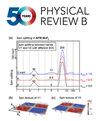二维Ti3C2Tx (T=O, F) MXene薄膜的表面声波和晶格振动
IF 3.7
2区 物理与天体物理
Q1 Physics and Astronomy
引用次数: 0
摘要
我们利用原子模拟研究了二维(2D)碳化钛(Ti3C2Tx) MXene薄膜中表面声波(SAW)的传播和晶格振动作为表面终止和层堆叠的函数。我们发现声表面波的传播速度对单层性能和层间键合都非常敏感。表面末端可以显著调节波的行为,氧和氟末端对波的传播产生明显的影响,由于层内键的加强,氧末端单层的波速比氟端单层高20%。关键的观察包括从一层到两层的转变,导致波速变化,以及层间模式的发展,产生更分散的晶格振动。随着膜层厚度的增加,声表面波的传播主要局限于上表面,振动模式的相干性在多层结构中减弱。这些发现表明,MXene终端和层堆叠是控制声表面波行为的关键参数,为新型声波器件的应用提供了有希望的途径。2025年由美国物理学会出版本文章由计算机程序翻译,如有差异,请以英文原文为准。
Surface acoustic waves and lattice vibrations in two-dimensional Ti3C2Tx (T=O, F) MXene films
We investigated surface acoustic wave (SAW) propagation and lattice vibrations in two-dimensional (2D) titanium carbide (Ti3C2Tx) MXene films as a function of surface termination and layer stacking, using atomistic simulations. We found that SAW propagation velocity is highly sensitive to both single-layer properties and interlayer bonding. Surface terminations significantly modulate wave behavior, with oxygen and fluorine terminations producing distinct effects on wave propagation, with oxygen-terminated monolayers exhibiting 20% higher wave speeds than fluorine counterparts due to strengthened intralayer bonds. Key observations include the transition from one to two layers causing wave speed variations, and the development of interlayer modes that generate more dispersed lattice vibrations. As the film layer thickness increases, SAW propagation becomes predominantly confined to the upper surface, with coherence of vibrational modes diminishing in multilayer structures. These findings suggest MXene terminations and layer stacking are crucial parameters for controlling SAW behavior, offering promising avenues for novel acoustic wave device applications. Published by the American Physical Society 2025
求助全文
通过发布文献求助,成功后即可免费获取论文全文。
去求助
来源期刊

Physical Review B
物理-物理:凝聚态物理
CiteScore
6.70
自引率
32.40%
发文量
0
审稿时长
3.0 months
期刊介绍:
Physical Review B (PRB) is the world’s largest dedicated physics journal, publishing approximately 100 new, high-quality papers each week. The most highly cited journal in condensed matter physics, PRB provides outstanding depth and breadth of coverage, combined with unrivaled context and background for ongoing research by scientists worldwide.
PRB covers the full range of condensed matter, materials physics, and related subfields, including:
-Structure and phase transitions
-Ferroelectrics and multiferroics
-Disordered systems and alloys
-Magnetism
-Superconductivity
-Electronic structure, photonics, and metamaterials
-Semiconductors and mesoscopic systems
-Surfaces, nanoscience, and two-dimensional materials
-Topological states of matter
 求助内容:
求助内容: 应助结果提醒方式:
应助结果提醒方式:


